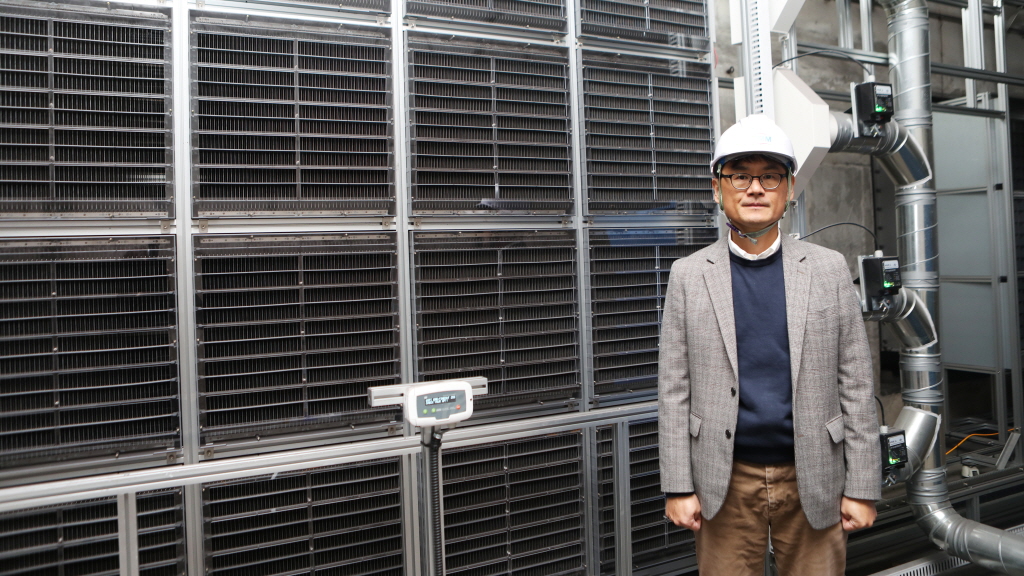한국기계연구원(기계연) 도시환경연구실 김학준 책임연구원 연구팀이 개발한 대용량 무필터 초미세먼지 저감 기술이 지하철을 시작으로 학교, 백화점 등 주요 공공시설에 도입되며 국민 생활환경 개선에 기여하고 있다. 이번 기술은 세계 최고 수준의 공기정화 성능과 경제성을 갖추어 대규모 실내 공간에서도 효율적으로 활용될 것으로 기대된다.
지하철·백화점·학교 등 대형 실내공간 국민 생활 개선
필터 교체 不, 유지비 절감 효과 크고·제작 비용 절감
한국기계연구원(이하 기계연)이 개발한 대용량 무필터 초미세먼지 저감 기술이 지하철을 시작으로 학교, 백화점 등 주요 공공시설에 도입되며 국민 생활환경 개선에 기여하고 있다. 이번 기술은 세계 최고 수준의 공기정화 성능과 경제성을 갖추어 대규모 실내 공간에서도 효율적으로 활용될 것으로 기대된다.
기계연은 최근 도시환경연구실 김학준 책임연구원 연구팀은 필터 없이 초미세먼지를 저감할 수 있는 정전기 기반 공기청정 기술을 개발했다고 밝혔다.
이 기술은 극세사 방전극과 비금속 탄소판을 사용해 낮은 전류로 작동하는 이 기술은 초미세먼지를 90% 이상 제거할 수 있다.
또한 오존 발생 농도를 일반 대기의 1/10 수준(5ppb 이하)으로 낮춰 기존 정전기 방식의 오존 문제를 해결했다.
이 기술은 필터 교체 비용이 없어 유지보수 비용 절감 효과가 크며, 대형 공간에서도 공기 흐름을 저하시키지 않아 효율적인 공기정화가 가능하다.
특히 지하철 터널용 장치는 덕트를 필요로 하지 않아 제작 비용을 기존 대비 30% 이상 절감할 수 있다.
기계연은 대전광역시 지하철 서대전네거리역과 오룡역, 중구청역 터널 구간에서 효과 검증을 완료했으며, 학교용으로 개발된 무필터 공기청정기를 부산광역시 초등학교에 설치해 실증 시험을 진행 중이다.
경기도 A백화점 공조기에서도 시험을 완료해 공공시설에서의 미세먼지 저감 효과를 확인했다.
이 제품은 CA 인증과 실증을 거쳐 보급 확대가 예정되어 있다.
기계연은 이번 기술의 경제성과 혁신성을 인정받아 국제전기집진기학회에서 ‘프레더릭 G. 코트렐 상’을 수상했다.
초기 도입 후 약 3년 내 손익분기점에 도달할 수 있는 경제성은 물론, 전기용품안전 KC 인증 및 공기청정기 단체품질 CA 인증을 통해 체계적인 보급을 준비하고 있다.
기계연 김학준 책임연구원은 “기존 정전기 방식의 오존 발생 문제를 근본적으로 해결한 유일한 기술”이라며 “초미세먼지 저감 전문 기업과의 기술 이전을 통해 상용화를 적극 추진 중”이라고 말했다.
기계연 류석현 원장은 “20년 이상의 연구 끝에 개발한 세계 최고 수준의 미세먼지 저감 기술로 국민 건강 증진에 기여하겠다”며 “앞으로도 더 많은 공공시설에 이 기술을 확대 적용할 계획”이라고 밝혔다.
이번 연구는 기계연의 기본사업과 과학기술정보통신부 지원으로 수행됐으며, 포스트 팬데믹 대응을 위한 친환경 스마트 공조 시스템을 목표로 진행됐다.
